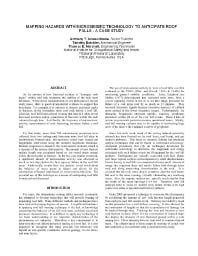Mining Publication: Mapping Hazards with Microseismic Technology to Anticipate Roof Falls - A Case Study
Original creation date: August 2004
Authors: AT Iannacchione, TJ Batchler, TE Marshall
NIOSHTIC2 Number: 20025351
Proceedings of the 23rd International Conference on Ground Control in Mining, Morgantown, West Virginia, August 3-5, 2004. Morgantown, WV: West Virginia University, 2004 Aug; :327-333
As the amount of new fractured surfaces or "damaged rock layers" within roof rock increases, the stability of the rock mass decreases. While direct measurements of this phenomenon are not easily made, there is good circumstantial evidence to support this hypothesis. For example, it is common to observe increased cracks or fractures in the immediate mine roof rock before a roof fall. Likewise, roof drill holes placed in areas that later fail often reveal increased numbers and/or separations of fractures within the rock column through time. And finally, the frequency of microseismic activity, representative of rock fracturing, increases before a roof fall. For this study, more than 700 microseismic emissions were collected from two underground limestone mine roof fall areas in southwestern Pennsylvania. Microseismic events were located and magnitudes determined using the moment magnitude technique. Moment magnitude is based on the event seismic moment, which is a measure of the seismic deformation. The amount of new fracture surface length was calculated based on the stored strain energy within the rock prior to fracture. In the two case studies presented, a significant amount of microseismic activity was observed as much as two days before the first signs of failure in the roof fall areas. Additionally, results from this analysis reveal much about the behavior of strata prone to failure and allows for the construction of hazard maps based on microseismic emissions. The potential use of this technique as a means of anticipating roof falls is analyzed and discussed.

NIOSHTIC2 Number: 20025351
Proceedings of the 23rd International Conference on Ground Control in Mining, Morgantown, West Virginia, August 3-5, 2004. Morgantown, WV: West Virginia University, 2004 Aug; :327-333
- Characteristics of Mining-Induced Seismicity Associated with Roof Falls and Roof Caving Events
- Detecting Strata Fracturing and Roof Failures from a Borehole Based Microseismic System
- An Evaluation of Microseismic Activity Associated with Major Roof Falls in a Limestone Mine: a Case Study
- Field Observations and Numerical Studies of Horizontal Stress Effects on Roof Stability in U.S. Limestone Mines
- Identifying Moisture Sensitive Roof Rocks in Coal Mines
- Major Hazard Risk Assessment Applied to Pillar Recovery Operations
- Methods for Determining Roof Fall Risk in Underground Mines
- The Relationship of Roof Movement and Strata-Induced Microseismic Emissions to Roof Falls
- Technology News 455 - Roof Hazard Alert Modules
- Using Major Hazard Risk Assessment to Appraise and Manage Escapeway Instability Issues: A Case Study